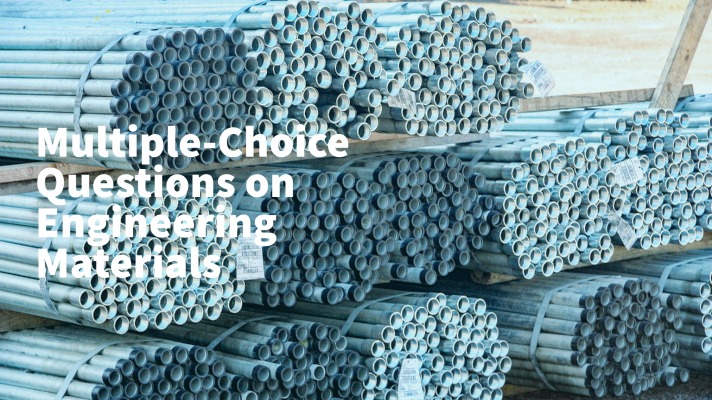When you don’t have much time in studying a long text, you read the Multiple-Choice Questions to collect a lot of information. In this article, I will keep some Multiple-Choice Questions on Engineering Materials that will help you in examinations and also in viva.
You all should know the information on Engineering materials irrespective of your stream in Engineering. Even, the MCQs mentioned here will be useful for you too if you are studying in a school.
In the last section, there will be a Quiz on Engineering Materials of 10 marks. Appear for the test and know how much depth you have in this topic. Thus, you can evaluate yourself.
At the end of this article, you will also find a PDF downloadable button from where you can download the PDF format of this MCQ sheet. So now let’s start the objective-type questions or viva questions on Engineering Materials.

MCQ questions or Viva Questions on Engineering Materials
Here are the MCQ questions or Objective Type Questions for you:
- Amorphous materials are:
- Crystalline solids
- Non-Crystalline solids
- Both (1) and (2)
- None of these
Ans: (2)
- A building material block of same unit of any material is termed as:
- Crystallography
- Bravious Lattice
- Both (1) and (2)
- None of these
Ans: (2)
- Atomic packing factor is:
- Volume of the unit cell / volume of atoms in a unit cell
- (Volume of the unit cell)2 / (volume of atoms in a unit cell)2
- Volume of atoms in a unit cell / Volume of the unit cell
- (Volume of atoms in a unit cell)2 / (Volume of the unit cell)2
Ans: (3)
- Which materials possess the BCC Structure?
- Manganese
- Niobium
- Both (1) and (2)
- None of these
Ans: (3)
- The atomic packing factor of BCC structured material is ____.
- 0.74
- 0.68
- 0.5
- None of these
Ans: (2)
- The atomic packing factor of a simple cubic structured material is ____.
- 0.74
- 0.68
- 0.5
- None of these
Ans: (3)
- The atomic packing factor of FCC structured material is ____.
- 0.74
- 0.68
- 0.5
- None of these
Ans: (1)
- The total number of atoms in a BCC unit cell is ____.
- 2
- 3
- 4
- 1
Ans: (1)
- The total number of atoms in a FCC unit cell is ____.
- 2
- 3
- 4
- 1
Ans: (3)
- Which structured material is harder?
- HCP
- FCC
- BCC
- None of these
Ans: (3)
- Which of the following is/are the points defects in the materials?
- Grain boundary defect
- Frenkel defect
- Substitutional defect
- Both (2) and (3)
Ans: (4)
- Which of the following is/are the surface defects in the materials?
- Grain boundary defect
- Frenkel defect
- Substitutional defect
- Both (2) and (3)
Ans: (1)
- Which of the following is/are the line defects in the materials?
- Interstitial defect
- Edge dislocation
- Substitutional defect
- Vacancy defect
Ans: (2)
- Which one of the following is the Gibbs phase rule?
- F-P=C+2
- F=P-C+1
- F=P+C+3
- F=C-P+2
Ans: (4)
- Which one of the following is the Condensed phase rule?
- F-P=C+2
- F=C-P+1
- F=P+C+3
- F=C-P+2
Ans: (2)
- The binary diagram comprises of ____.
- Two metals
- A metal and a compound
- Two compounds
- All of these
Ans: (4)
- Internal variable composition is denoted by ‘C’.In a unary diagram, value of C is:
- 1
- 2
- 3
- 4
Ans: (1)
- The eutectoid composition of ferrite and cementite is termed as ____.
- Austenite
- Ferrite
- Pearlite
- None of these
Ans: (3)
- Which of the following material acts as deoxidizer?
- Mn
- Mo
- Si
- V
Ans: (3)
- The hardest phase of Iron is ____.
- Martensite
- Cementite
- Ferrite
- None of these
Ans: (1)
- In the TTT diagram, when the cooling rate touches the nose of the diagram, it is called ____.
- Maximum cooling rate
- Critical cooling rate
- Minimum cooling rate
- None of these
Ans: (2)
- Which of the following curve / curves is / are termed as TTT diagram?
- C-Curve
- S-Curve
- Bains-Curve
- All of these
Ans: (4)
- Bainite can be produced by ____.
- Continuous cooling
- Quenching below the nose of the TTT diagram
- Quenching above the Martensite start line
- Both (2) and (3)
Ans: (4)
- The process of making Bainite is known as ____.
- Annealing
- Austempering
- Normalizing
- None of these
Ans: (2)
- The main purpose of Annealing is ____.
- To reduce hardness
- To increase ductility
- Both (1) and (2)
- None of these
Ans: (3)
- High temperature tempering is performed at ____.
- 350-500 Degree C
- 500-650 Degree C
- Below 250 Degree C
- None of these
Ans: (2)
- Brinell hardness number is the ratio of ____.
- Applied load and area of impression
- Area of impression and applied load
- None of these
Ans: (1)
- The alloy of aluminium, magnesium, and chromium of small quantity is known as ____.
- Magnalium
- Y-alloy
- Hindalium
- None of these
Ans: (3)
- The alloy of aluminium, magnesium, copper, and manganese is known as ____.
- Magnalium
- Y-alloy
- Hindalium
- Duralumin
Ans: (4)
- Gun metal is an alloy of ____.
- Copper, Tin, and Zinc
- Copper, Tin, Lead
- Copper, Tin, and Cadmium
- None of these
Ans: (1)
- The white metals are:
- Tin base alloys
- Lead base alloys
- Both (1) and (2)
- None of these
Ans: (3)
Quiz on Engineering Materials
Here is the Quiz for you:
Conclusion
I hope that the Multiple-Choice Questions on Engineering Materials will help you in getting high scores in your college / university examinations and in different types of competitive examinations. If you find any discrepancies in the answers, please let me know by writing in the comment box. Good Luck!


